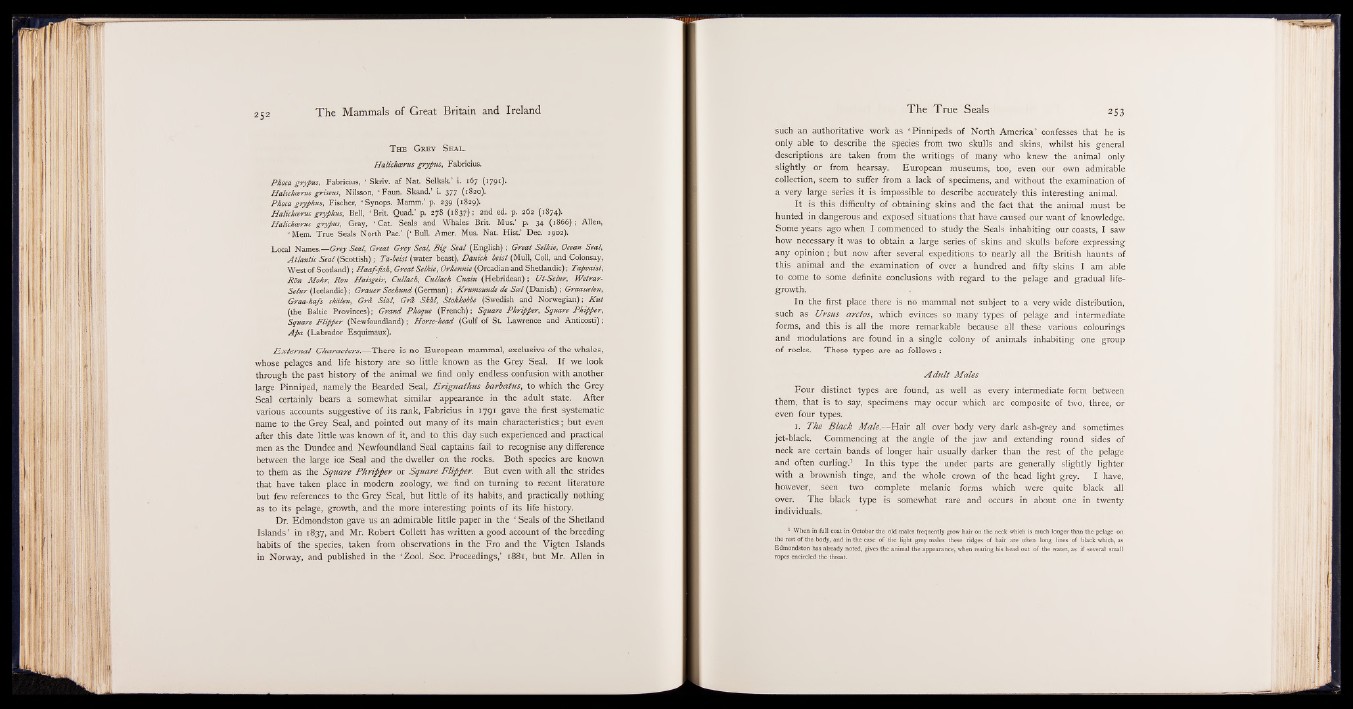
T h e G r e y S e a l .
Halichcerus grypus, Fabricius.
Phoca grypus, Fabricius, ‘ Skriv. a f Nat. Selksk.’ i. 167 (1791).
Halichcerus griseus, Nilsson, * Faun. Skand.’ i. 377 (1820).
Phoca gryphus, Fischer, ‘ Synops. Mamm.’ p. 239 (1829).
Halichcerus gryphus, Bell, ‘ Brit. Quad.’ p. 278 (1837) ; 2nd ed. p. 262 (1874).
Halichcerus grypus, Gray, ‘ Cat. Seals and Whales Brit. Mus.’ p. 34 (1866); Allen,
‘ Mem. True Seals North Pac.’ (‘ Bull. Amer. Mus. Nat. His t’ Dec. 1902).
Local Names.— Grey Seal, Great Grey Seal, B ig S ea l (English); Great S elkie, Ocean Seal,
A tla n tic S ea l (Scottish); Ta-beist (water beast), Danich heist (Mull, Coll, and Colonsay,
West of Scotland) ; H aaf-fish, Great Selkie, Orkennie (Orcadian and Shetlandic); Tapvaist,
Ron M ohr, Ron H aisgeir, Cullach, Cullach Cuain (Hebridean) ; U t-Selur, Wetrar-
S elur (Icelandic); Grauer Seehund (German); Krumsunde de Seel (Danish) ; Graascelen,
Graa-hafs skalen, Gr& S ia l, Gr& S k ill, Stokkobbe (Swedish and Norwegian); K u t
(the Baltic Provinces); Grand Phoque (French); Square Phripper, Square Phipper,
Square F lip p er (Newfoundland) ; Horse-head (Gulf o f S t Lawrence and Anticosti);
Apa (Labrador Esquimaux).
E xternal Characters.— There is no European mammal, exclusive of the whales,
whose pelages and life history are so little known as the Grey Seal. If we look
through the past history of the animal we find only endless confusion with another
large Pinniped, namely the Bearded Seal, Erignathus barbatus, to which the Grey
Seal certainly bears a somewhat similar appearance in the adult state. After
various accounts suggestive of its rank, Fabricius in 1791 gave the first systematic
name to the Grey Seal, and pointed out many of its main characteristics; but even
after this date little was known of it, and to this day such experienced and practical
men as the Dundee and Newfoundland Seal captains fail to recognise any difference
between the large ice Seal and the dweller on the rocks. Both species are known
to them as the Square Phripper or Square Flipper. But even with all the strides
that have taken place in modern zoology, we find on turning to recent literature
but few references to the Grey Seal, but little of its habits, and practically nothing
as to its pelage, growth, and the more interesting points of its life history.
Dr. Edmondston gave us an admirable little paper in the ‘ Seals of the Shetland
Islands ’ in 1837, and Mr. Robert Collett has written a good account of the breeding
habits of the species, taken from observations in the Fro and the Vigten Islands
in Norway, and published in the ‘ Zool. Soc. Proceedings,’ 1881, but Mr. Allen in
such an authoritative work as ‘ Pinnipeds of North America’ confesses that he is
only able to describe the species from two skulls and skins, whilst his general
descriptions are taken from the writings of many who knew the animal only
slightly or from hearsay. European museums, too, even our own admirable
collection, seem to suffer from a lack of specimens, and without the examination of
a very large series it is impossible to describe accurately this interesting animal.
It is this difficulty of obtaining skins and the fact that the animal must be
hunted in dangerous and exposed situations that have caused our want of knowledge.
Some years ago when I commenced to study the Seals inhabiting our coasts, I saw
how necessary it was to obtain a large series of skins and skulls before expressing
any opinion; but now after several expeditions to nearly all the British haunts of
this animal and the examination of over a hundred and fifty skins I am able
to come to some definite conclusions with regard to the pelage and gradual life-
growth.
In the first place there is no mammal not subject to a very wide distribution,
such as Ursus arctos, which evinces so many types of pelage and intermediate
forms, and this is all the more remarkable because all these various colourings
and modulations are found in a single colony of animals inhabiting one group
of rocks. These types are as follows :
A d u lt Males
Four distinct types are found, as well as every intermediate form between
them, that is to say, specimens may occur which are composite of two, three, or
even four types.
1. The Black Male.— Hair all over body very dark ash-grey and sometimes
jet-black. Commencing at the angle of the jaw and extending round sides of
neck are certain bands of longer hair usually darker than the rest of the pelage
and often curling.1 In this type the under parts are generally slightly lighter
with a brownish tinge, and the whole crown of the head light grey. I have,
however, seen two complete melanic forms which were quite black all
over. The black type is somewhat rare and occurs in about one in twenty
individuals.
1 When in full coat in October the old males frequently grow hair on the neck which is much longer than the pelage on
the rest of the body, and in the case of the light grey males these ridges of hair are often long lines of black which, as
Edmondston has already noted, gives the animal the appearance, when rearing his head out of the water, as if several small
ropes encircled the throat.